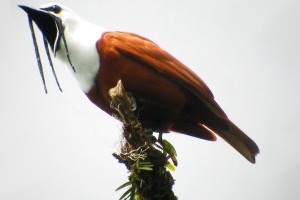Kingdom animalia
Phylum Chordata
Class Amphibia
Order gymnophiona
The Amphibia Class is divided into three Orders: the Anura, whose representatives are toads, frogs and tree frogs; Caudata Order, with salamanders and newts; and Gymnophiona, represented by blind snakes and caecilians. They are usually found buried, in moist soil or in water, feeding on subterranean animals and other small living beings.
These animals, typical of tropical regions, have a cylindrical, elongated and ringed body, and have neither legs nor tails. As for the head, they have a solid skull. The eyes, most of the time, are atrophied, living up to her vulgar name. However, these animals have sensory tentacles, which help in this regard. In addition to these two openings, there are also the nostrils.
Males have a copulatory organ, the phallode, which provides for internal fertilization. There are oviparous and viviparous individuals. In the case of the first ones, the females develop parental care, that is, they take care of their young until they are able to survive on their own. In certain species, such as the
Siphonops annulatus, found widely in our country, newborns are depigmented and quite fragile; and the mother has curious characteristics: she does not feed during this period and, furthermore, her coloration becomes more opaque. Recently, researchers found that this change in the skin of female caecilians occurs because the chicks feed on their epidermis, aided by special teeth. For food, they also suck a viscous secretion that the mother releases through the cloacal opening.Do not stop now... There's more after the advertising ;)
As for viviparous, some larvae can stay for up to a year in the females' oviduct, feeding, after three months of life, a nutritious secretion produced by the wall of the uterus, using its teeth.
Gymnophions are often confused with two-headed snakes. These, belonging to the amphisbenidae family, are reptiles, endowed with scales. Furthermore, the cloaca of these animals is transversal in relation to the plane of the trunk. Blind snakes, on the other hand, do not have scales, the cloaca is longitudinal and its body has keratinized rings along its length.
By Mariana Araguaia
Graduated in Biology
Would you like to reference this text in a school or academic work? Look:
ARAGUAIA, Mariana. "Blind Snakes and Cecilias (Order Gymnophiona)"; Brazil School. Available in: https://brasilescola.uol.com.br/animais/cobrascegas-ceciliasordem-gymnophiona.htm. Accessed on June 27, 2021.


